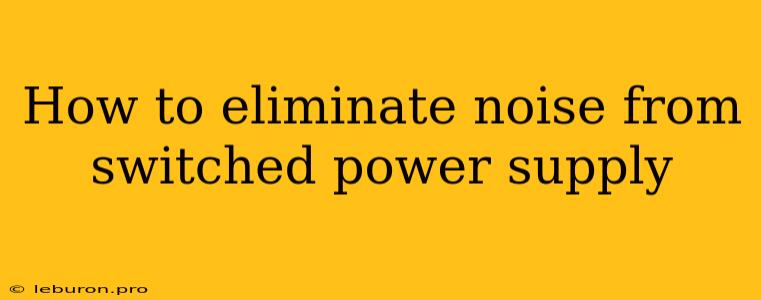Switched-mode power supplies (SMPS) are ubiquitous in modern electronics, offering high efficiency and compact designs. However, a common drawback of SMPS is the generation of noise, which can interfere with sensitive circuits or create unwanted audible hum. Understanding the sources of noise and implementing effective noise reduction techniques are crucial for ensuring the performance and reliability of electronic systems. This article will delve into the intricacies of noise generation in switched power supplies and provide practical solutions for its elimination.
Understanding Noise in Switched Power Supplies
Noise in switched power supplies arises from the switching process itself, which involves rapid changes in current and voltage. These abrupt transitions create electromagnetic interference (EMI) that can propagate through various paths, affecting both the power supply itself and nearby circuits.
Sources of Noise in SMPS
Several factors contribute to noise generation in switched power supplies:
- Switching Transients: The high-speed switching of transistors in the SMPS generates sharp voltage and current spikes, leading to radiated and conducted EMI.
- Inductor and Capacitor Ripples: The switching action creates ripple currents in inductors and capacitors, resulting in voltage fluctuations across these components.
- Diode Switching Noise: The switching of diodes in rectifier circuits can generate noise due to the fast rise and fall times of their current.
- Resonances: The interaction between components in the SMPS circuit, such as inductors and capacitors, can lead to resonant frequencies that amplify noise.
Techniques for Eliminating Noise from Switched Power Supplies
Eliminating noise from switched power supplies involves addressing the sources of noise and implementing strategies to minimize their impact. Common techniques include:
1. Careful Circuit Design
Proper circuit design plays a crucial role in mitigating noise. Techniques to consider include:
- Layout Optimization: Keeping switching components close to each other and minimizing loop areas for switching currents can reduce radiated EMI.
- Component Selection: Choosing components with low parasitic inductance and capacitance can minimize ripple currents and voltage fluctuations.
- Snubber Circuits: Snubber circuits damp switching transients by dissipating energy through resistors and capacitors.
- Shielding: Enclosing sensitive components with metal shields can prevent electromagnetic radiation from reaching external circuits.
2. Filtering Techniques
Filters are essential for attenuating noise frequencies. Common filter types include:
- Input Filters: These filters are placed at the input of the SMPS to suppress high-frequency noise from the power source.
- Output Filters: These filters are placed at the output of the SMPS to smooth out voltage fluctuations and reduce ripple.
- LC Filters: These filters use inductors and capacitors to create a low-pass response, attenuating high-frequency noise.
- RC Filters: These filters use resistors and capacitors to create a low-pass response, similar to LC filters.
3. Grounding and Shielding
Effective grounding and shielding are critical for minimizing noise propagation.
- Grounding: Providing a low-impedance path for noise currents to ground can reduce conducted EMI.
- Shielding: Enclosing sensitive components or cables with metal shields can prevent electromagnetic radiation from affecting other circuits.
4. EMI Reduction Techniques
Specific techniques to minimize electromagnetic interference include:
- Ferrites: Placing ferrite beads on wires carrying switching currents can reduce radiated EMI.
- Chokes: Inductors known as chokes are used to suppress high-frequency noise currents in power lines.
- Capacitors: Capacitors can be used to filter out high-frequency noise currents.
- Magnetic Shielding: Utilizing magnetic materials to create a barrier around sensitive components can block electromagnetic fields.
Conclusion
Eliminating noise from switched power supplies requires a multi-pronged approach, incorporating careful circuit design, filtering techniques, proper grounding and shielding, and EMI reduction techniques. By addressing the sources of noise and implementing effective mitigation strategies, you can minimize unwanted noise and ensure the reliable operation of your electronic systems. Remember that noise reduction is an iterative process, and careful testing and optimization are essential to achieve the desired noise levels.
